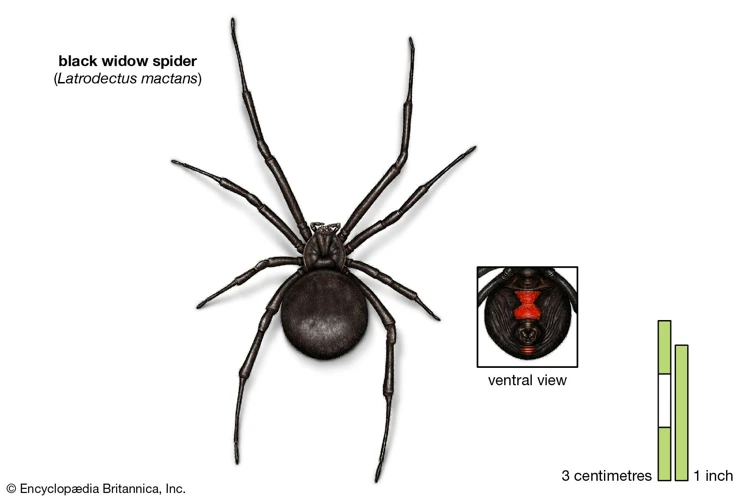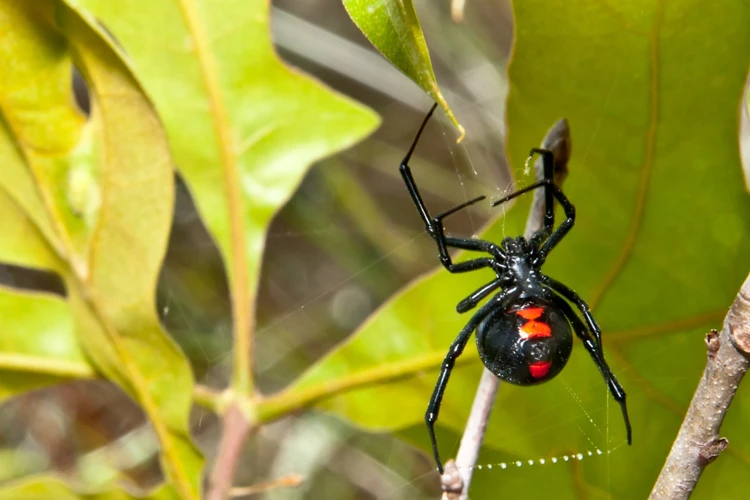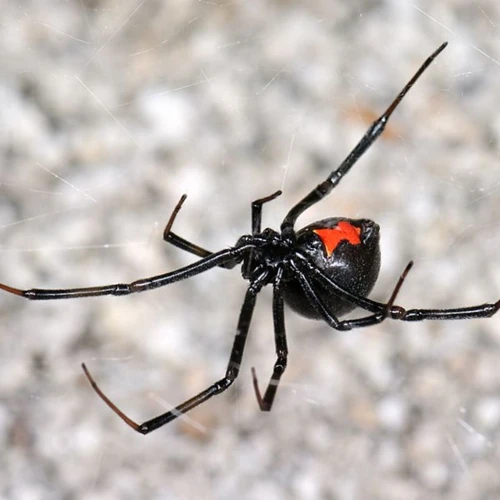Introduction

When it comes to spiders, the black widow is one of the most well-known, and for good reason. Their distinctive abdomens with the red hourglass shape on the underside is an unmistakable feature. But despite their notoriety, there are still many questions about the behavior and habits of these spiders. One such question is whether or not black widows hunt in packs or are solitary creatures. Let’s delve into the habits of these fascinating arachnids and find out the truth.
Overview of Black Widow Spiders
Black Widow Spiders is a species of spiders known for their distinctive black color and the red hourglass shape on their abdomen. They are found in areas with warm climates, including the United States, Australia, and Africa.
Black Widow Spiders are renowned for their venomous bite, which can be fatal to humans in some cases. To avoid any danger, it is essential to understand their behavior and hunting habits. Here is a table providing an overview of the physical characteristics and behavior of the Black Widow Spider:
| Physical Characteristics: | Behavior: |
| Size: 1-1.5 inches long | Prefer dark, dry spaces |
| Color: Black with red hourglass shape on abdomen | Solitary creatures |
| Venom: Neurotoxins effective on the nervous system of their prey | Hide in webs when not hunting |
| Lifespan: Up to one year in the wild | Hunt at night |
| Diet: Small insects and other spiders | Use silk to secure their prey |
As seen in the table, Black Widow Spiders are solitary creatures that prefer to hunt at night in dark, dry spaces. They use silk to secure their prey, which consists of small insects and other spiders. Their venom is composed of neurotoxins that are effective on the nervous system of their prey.
If you want to learn more about the diet and hunting habits of Black Widow Spiders, you can check our article on Black Widow Spider Diet. Alternatively, if you want to know how to protect your home from black widow prey, check out our guide on Protecting Homes from Black Widow Prey.
Black Widow Spider Behavior

Curious about the behavior of Black Widow Spiders? These arachnids are infamous for their venom and have developed a reputation as one of the world’s deadliest spiders. However, there is much more to their behavior than just their venomous bite. From their solitary nature to their mating habits, let’s take a closer look at the behavior of these fascinating creatures.
Solitary Creatures
Black Widow spiders are known for being solitary creatures. They are most commonly found living alone rather than in groups or packs. Female Black Widow spiders, in particular, tend to keep to themselves. They build their webs in dark, sheltered locations, often hiding in crevices or small spaces. Although they may live in close proximity to other spiders, they typically do not interact or hunt together.
Why are Black Widow spiders solitary creatures?
One reason why Black Widow spiders are solitary creatures is because of their cannibalistic nature. Female Black Widow spiders are known to eat their male counterparts after mating, which provides them with the necessary nutrients during pregnancy. Additionally, Black Widow spiders are highly territorial, and they may become aggressive towards other spiders that come too close to their web.
Do Black Widow spiders ever socialize or hunt together?
While it is possible for Black Widow spiders to live in groups, this behavior is rare and has only been observed in captivity. In the wild, Black Widow spiders typically hunt alone. They use their webs to capture prey, which they then immobilize with their venomous bite.
There are various theories as to why Black Widow spiders are solitary creatures. Some researchers believe that living alone may help them avoid competition and reduce the chances of becoming prey to other spiders or predators. Other researchers suggest that Black Widow spiders may have evolved to be solitary in order to increase their chances of successful breeding and survival.
Conclusion
Black Widow spiders are known for being solitary creatures, living alone and rarely interacting or hunting together. While it is possible for them to live in groups, this behavior is rare and has only been observed in captivity. Their cannibalistic nature and territorial behavior may be some reasons why they prefer to live alone. By hunting alone, Black Widow spiders increase their chances of survival and successful breeding. To learn more about Black Widow spiders and their hunting habits, check out our article on Black Widow Spider Hunting Habits.
Mating Habits
Black widow spiders have complex mating habits that significantly differ from other spider species. The black widow is known for the sexual cannibalism that occurs after mating, where the female tends to eat the male. In general, male black widow spiders are smaller and less intimidating than females, which can lead to fatal courtship. While sexual cannibalism can lead to males avoiding females altogether, it does not stop males from attempting mating.
Male black widows tend to engage in a behavior known as “mate binding,” where they wrap silk over the female genital opening to prevent another male from mating with the same female. After copulation, the male attempts to escape quickly and minimize the risk of getting eaten by the female. However, this seldom happens; females are usually intent to eat the male, and the male almost always perishes.
Interestingly, black widow spiders are known to copulate more than once, increasing the chances of successful reproduction and fertilization. Males also tend to be highly selective when choosing mates as they prefer females that have recently fed, making their web stronger and more durable.
| Black Widow spiders’ mating habits at a glance: |
| Male black widow spiders can be significantly smaller than females, which puts them at risk of being killed during courtship. |
| After copulation, males tend to wrap females with silk around their genital opening to prevent another male from mating with the same female. |
| Black widow spiders can copulate more than once, increasing the chances of successful reproduction and fertilization. |
| Males prefer to mate with females who have recently fed, making their web stronger and more durable. |
Black widow spiders’ mating habits are not only interesting but also unique. Sexual cannibalism may seem strange to some, but for black widow spiders, it is part of their life cycle. These practices ensure survival and healthy reproduction of the species. To learn more about black widow spiders and their behavior, check out what black widow spiders eat to sustain their hunger, the difference in diet between males and females, the effectiveness of black widow venom, and how many prey they eat per day.
Black Widow Spider Hunting Habits
As highly venomous spiders, black widows are known for their unique hunting habits that help them capture prey. In this section, we will delve into the hunting habits of black widow spiders, exploring their techniques for catching prey, the types of prey they consume, and whether or not they hunt in groups. By understanding the behavior and habits of these spiders, we can gain insight into how they have adapted to their environment and evolved over time. Let’s explore the fascinating world of black widow spider hunting!
Hunting Techniques
Black widow spiders are known for their hunting abilities, which have been fine-tuned over centuries of evolution. Their hunting techniques involve various methods that allow them to catch their prey with ease.
One of the primary hunting techniques used by black widow spiders is the use of their webs. These spiders spin webs that are incredibly strong and sticky, which act as a trap for their prey. Once caught in the web, the prey is unable to move and is quickly subdued by the spider.
Another hunting technique used by black widow spiders is stealth. These spiders are expert at blending in with their surroundings, making them almost invisible to their prey. Once they spot a potential meal, they move slowly and carefully, waiting for the perfect moment to strike.
Black widow spiders are also known for their speed and agility. They can move quickly when they need to and can jump surprising distances to catch their prey. They are known to use their venom to immobilize their prey quickly and effectively.
It’s important to note that black widow spiders are solitary creatures and do not hunt in packs. Each spider is responsible for their own hunting and survival.
Black widow spiders have multiple hunting techniques at their disposal, including their webs, stealth, speed, agility, and venom. These techniques allow them to catch their prey with ease and survive in their natural environment.
To learn more about the prey of black widow spiders, check out our article on Black Widow Spider Prey. Or, if you’re interested in their diet variations, read our article on Diet Variations of Black Widow Spiders.
Prey
Black widow spiders are known for their unique hunting techniques and their prey preferences. Despite their small size, black widow spiders are able to catch and consume prey that are several times their size. Their diet largely consists of insects, but they have also been known to prey on small reptiles and mammals. Let’s take a closer look at the prey preferences of black widow spiders in the table below:
| Prey Type | Description |
|---|---|
| Insects | Black widow spiders are known to prey on a variety of insects such as flies, mosquitoes, and grasshoppers. They use their webs to entangle and immobilize their prey. |
| Arachnids | Black widow spiders have been observed preying on other spiders, including those significantly larger than themselves. |
| Reptiles | Black widow spiders have been known to prey on small lizards and snakes, but this is a less common occurrence. |
| Mammals | Although rare, black widow spiders have been known to prey on small mammals such as mice and shrews. This is a testament to their powerful venom, which can be deadly to animals much larger than themselves. |
It is important to note that black widow spiders do not actively seek out larger prey items, but rather opportunistically feed on whatever crosses their path. Additionally, black widow spiders benefit many ecosystems through their predation of insects, forming a symbiotic relationship with other organisms. To learn more about this topic, check out our article on black widow prey symbiosis.
Group Hunting?
Black widow spiders are well-known hunters, but do they hunt in packs or alone? While many types of spiders have been observed to collaborate in hunting, black widows are not among them. Black widow spiders are solitary creatures and usually hunt alone, although they may occasionally share a web with other spiders.
Why Are Black Widow Spiders Solitary?
Black widow spiders are solitary creatures, meaning they tend to live and hunt alone. This is partly due to their territorial nature. Black widows defend their webs from other spiders and insects that may pose a threat or try to compete with them for food.
Group Hunting in Other Spider Species
Group hunting is observed in several spider species such as the wolf spider, crab spider, and jumping spider. These spiders may collaborate during hunting to capture larger prey or to defend themselves against predators. However, black widow spiders have not been observed to hunt in groups.
Black Widow Spider Hunting Techniques
Black widow spiders are ambush predators. They spin webs to capture prey, using their exceptional weaving skills and powerful venom to secure their meals. They tend to wait patiently inside or near their webs until an unsuspecting prey gets entangled in the sticky strands. At this point, they quickly strike, biting the prey with their venomous fangs and immobilizing it.
What Do Black Widows Eat?
Black widow spiders predominantly feed on insects, but they may also eat other spiders, small animals, and even each other. Females also sometimes eat their mates after mating, hence their name “black widow.” Their venom is potent and contains a neurotoxin that can cause muscle spasms, paralysis, and in severe cases, death.
Conclusion
Black widow spiders are solitary creatures that usually hunt alone, relying on their excellent weaving and ambushing skills to catch their prey. While some spider species may hunt in groups, black widows are not among them. Although they are known for their venomous bites and infamous mating habits, black widow spiders play an important role in controlling insect populations in their natural environments.
Conclusion
After researching and analyzing the behavior and hunting habits of black widow spiders, it is safe to say that these arachnids are solitary creatures by nature. They do not hunt in packs, but rather prefer to hunt alone.
Furthermore, black widow spiders have unique mating habits and in some cases, the female may kill and consume the male after mating. This reinforces the idea that black widow spiders are not sociable creatures and prefer to go through life alone.
In terms of hunting techniques, black widow spiders have a range of ways to catch their prey, including weaving sticky webs and ambushing their prey. Their diet consists of insects, arachnids, and even small vertebrates.
There is insufficient evidence to suggest that black widow spiders hunt in packs. In fact, it is unlikely given their solitary tendencies and hunting techniques.
Through this research, we can conclude that black widow spiders do not hunt in packs and prefer to live and hunt alone. However, their unique behavior and hunting habits make them fascinating creatures to study and observe.
Frequently Asked Questions
Are black widow spiders dangerous?
Yes, black widow spiders are venomous and can be dangerous to humans. Their venom can cause muscle pain, cramps, nausea, and even paralysis in some cases. However, fatalities are rare.
Do black widow spiders bite only when threatened?
Black widow spiders are usually non-aggressive and will only bite when provoked or threatened. However, if they feel their web is being disturbed, they may bite without warning.
What do black widow spiders eat?
Black widow spiders feed on a variety of insects and other arachnids including flies, mosquitoes, grasshoppers, and even other spiders.
How do black widow spiders catch their prey?
Black widow spiders catch their prey by using their webs to trap flying insects and crawling arthropods. Once trapped, the spider will bite its prey and immobilize it with its venom before consuming it.
What is the mating ritual of black widow spiders?
The male black widow spider performs a courtship ritual, which usually involves tapping on the female’s web to signal his interest. If the female accepts his advances, mating occurs. However, the male is often killed and eaten by the female after mating.
Can black widow spiders hunt in packs?
No, black widow spiders are solitary creatures and do not hunt in packs.
What is the lifespan of a black widow spider?
The lifespan of a black widow spider can vary depending on factors like temperature and food availability. Females can live up to three years while males usually only live for a few months.
How can you prevent black widow spider infestations?
You can prevent black widow spider infestations by clearing away clutter and debris, sealing up cracks and crevices, and keeping your home free of flying insects and crawling arthropods that may attract spiders.
What should you do if you are bitten by a black widow spider?
If you are bitten by a black widow spider, seek medical attention immediately. Symptoms can be managed with pain medication and other treatments, but it’s important to get professional help to ensure a full recovery.
Where can black widow spiders be found?
Black widow spiders can be found throughout the United States and in other parts of the world. They prefer warm and dry habitats and are commonly found in woodpiles, rock piles, and other areas with ample shelter and food sources.






